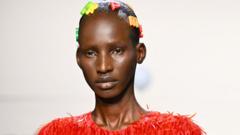In the world of high fashion, South Sudanese models are becoming increasingly prominent, driven by their unique beauty and undeniable talent. Arop Akol, an emerging star in the modeling arena, reflects on her journey, sharing insights from her experiences in major fashion capitals like London and Paris. Having begun her modeling career just three years ago, Akol has already walked alongside icons like Naomi Campbell. The remarkable physical traits of South Sudanese models, characterized by perfect dark skin and height, have made them highly sought after in the industry.
Renowned figures such as Alek Wek, Adut Akech, and Anok Yai have established a legacy of success for South Sudanese models. The fashion community is taking notice, with a significant representation of South Sudanese talent in annual talent lists and magazine features. Industry experts attribute the growing appeal of these models to their resilience, a trait honed from their experiences in a nation that has faced turmoil and displacement since gaining independence in 2011.
Despite the global acclaim, many South Sudanese models face challenges. From financial hurdles at the onset of their careers to cultural stigmas surrounding modeling, the journey is often fraught with complications. However, as more models find success and support from their communities, there's a shift in perception, with increasing acceptance of modeling as a viable career. Industry advocates assert that diversity and representation are becoming vital in fashion, ensuring that the influence of South Sudanese models continues to flourish worldwide.
While the fashion industry may evolve, the allure of South Sudanese models appears poised to endure, as Akol asserts, "South Sudanese models are going to go a long way." Their compelling stories and unmatched talent are surely here to stay on the global stage.
Renowned figures such as Alek Wek, Adut Akech, and Anok Yai have established a legacy of success for South Sudanese models. The fashion community is taking notice, with a significant representation of South Sudanese talent in annual talent lists and magazine features. Industry experts attribute the growing appeal of these models to their resilience, a trait honed from their experiences in a nation that has faced turmoil and displacement since gaining independence in 2011.
Despite the global acclaim, many South Sudanese models face challenges. From financial hurdles at the onset of their careers to cultural stigmas surrounding modeling, the journey is often fraught with complications. However, as more models find success and support from their communities, there's a shift in perception, with increasing acceptance of modeling as a viable career. Industry advocates assert that diversity and representation are becoming vital in fashion, ensuring that the influence of South Sudanese models continues to flourish worldwide.
While the fashion industry may evolve, the allure of South Sudanese models appears poised to endure, as Akol asserts, "South Sudanese models are going to go a long way." Their compelling stories and unmatched talent are surely here to stay on the global stage.


















